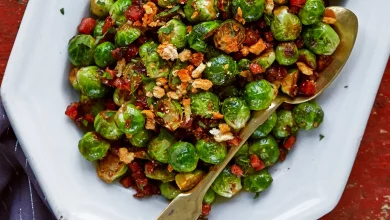Mastering Creole Rice Dressing: A Taste of Louisiana’s Culinary Heritage

Louisiana cuisine is a symphony of flavors and traditions, and at the heart of it lies the humble yet indispensable ingredient – rice. Whether it’s a daily meal or a festive occasion like Thanksgiving, a Louisianan feast is incomplete without this staple. When the holiday season rolls around, Creole Rice Dressing takes center stage, sharing the spotlight with the Thanksgiving turkey and all its accompaniments. It’s worth noting that Creole Rice Dressing doesn’t replace classics like cornbread dressing; instead, it complements the meal, offering a distinctive Southern touch.
Contents
Creole Rice Dressing vs. Dirty Rice

Some might use the terms "rice dressing" and "dirty rice" interchangeably, but in the realm of Louisiana cuisine, there’s a nuanced difference. Dirty rice typically includes gizzards and livers, adding a depth of flavor and texture. In contrast, Creole Rice Dressing, the star of our discussion, omits these ingredients, focusing on a more straightforward yet equally delicious combination of rice, ground meat, and aromatics.
The Flavorful Alchemy
What sets Creole Rice Dressing apart is the harmonious blend of ingredients that create a symphony of flavors. Here’s what you’ll need to bring this dish to life:
- 1½ cups of long-grain white rice
- 2 tablespoons of extra-virgin olive oil
- 1¾ pounds of ground pork
- 4 teaspoons of Creole seasoning (ideally, Tony Chachere’s Original), divided
- 1 large onion, finely chopped
- 1 large green bell pepper, ribs and seeds removed, finely chopped
- 4 celery stalks, thinly sliced
- 6 garlic cloves, finely chopped
- 1 tablespoon plus 1 teaspoon of Worcestershire sauce
- 1 tablespoon (or more) of hot sauce
- 1 teaspoon of freshly ground pepper
- ½ teaspoon of Diamond Crystal or ¼ teaspoon of Morton kosher salt, plus more
- 1 bunch of scallions, using the dark green parts only, thinly sliced
- ¼ cup finely chopped parsley
The Creole Seasoning Secret
In the world of Creole cuisine, the choice of seasoning can make a significant difference. Many Louisianans rely on Tony Chachere’s Original Creole Seasoning to infuse their dishes with that unmistakable Creole flavor. However, seasoning blends can vary greatly in saltiness. For instance, Lawry’s is saltier than some grocery store brands’ Cajun or Creole seasoning. So, a word of caution: Taste your dish at the very end and adjust the salt as needed, especially if you opt for a different seasoning blend.
Crafting Creole Rice Dressing
Now, let’s take a culinary journey into crafting Creole Rice Dressing. The process involves a few key steps:
1. Preparing the Rice
Start by rinsing 1½ cups of long-grain white rice until the water runs clear. Transfer the rice to a medium saucepan and add 2 cups of water. Bring it to a boil, then reduce the heat to low, and cover. Allow it to cook until the water is absorbed, which typically takes about 16-18 minutes. Once done, remove it from heat and let it sit, still covered, for 10 minutes. Finally, uncover the rice, fluff it with a fork, and let it cool. Alternatively, you can use a rice cooker or 3 cups of leftover cooked long-grain white rice.
Final Thoughts
Creole Rice Dressing is a delightful addition to your Thanksgiving table, or any time you’re craving a taste of Louisiana. It embodies the soul of Creole cuisine, offering a unique blend of flavors that is bound to please the palate. With the right Creole seasoning and a little culinary finesse, you can create a dish that pays homage to a rich culinary heritage.
So, give Creole Rice Dressing a try and savor the flavors of Louisiana in your own kitchen. It’s a true taste of the South.
Common Inquiries about Creole Rice Dressing and Themed Questions
How do you make Cajun rice dressing?
Cajun rice dressing, a beloved traditional dish, is a delightful blend of flavors. To craft this Southern favorite, follow these simple steps:
-
Prepare the Roux: Begin by creating a roux, the heart of Cajun cuisine. Heat oil over medium heat in a large pot, such as a Dutch oven, until it’s hot. Stir in the flour, combining them to form the foundation of your dish.
-
Add the Cajun Trinity: The essence of Cajun flavor comes from the holy trinity of onion, bell pepper, and celery. Incorporate these aromatic vegetables into your roux, infusing it with a rich, savory essence.
-
Simmer with Ground Meats: Next, simmer the roux and trinity with ground meats, creating a flavorful stock that will elevate your rice dressing. This step imparts depth and complexity to the dish.
-
Mix with Cooked White Rice: Once your stock is ready, combine it with cooked white rice, fusing the distinctive Cajun flavors with the comforting familiarity of rice. The result is a mouthwatering Cajun rice dressing, ready to delight your taste buds.
Crafting Cajun rice dressing is a culinary journey that pays homage to Louisiana’s rich culinary heritage, and it’s a treat worth savoring.
What is Louisiana Rice Dressing?
Louisiana Rice Dressing, a classic in Southern Louisiana cuisine, is distinct from dirty rice. It is a traditional dish that captures the essence of the region. Here’s a brief overview:
-
Not Dirty Rice: Unlike its cousin, dirty rice, Louisiana Rice Dressing follows a unique path. It’s not characterized by the inclusion of gizzards and livers, making it a milder yet equally delightful dish.
-
Roux-Based Stock: At the heart of this Louisiana favorite is a rich stock, crafted from a roux base. The roux, made by blending oil and flour, sets the stage for a deep, flavorful foundation.
-
Infused with Ground Meats: Ground meats are added to the roux-based stock, infusing the dish with savory and aromatic notes. This step brings depth and complexity to the rice dressing.
Louisiana Rice Dressing is a culinary gem that showcases the soul of Southern Louisiana, a testament to the region’s rich gastronomic heritage.
What is Cajun Farre Rice Dressing?
Cajun Farre Rice Dressing is a delectable variation of the classic dirty rice recipe, also known as Dirty Rice Jambalaya. This dish is thoughtfully enhanced, making it a perfect choice for holiday feasts. Here’s what sets it apart:
-
Roux Elevation: To jazz up this Cajun delight, a small roux is introduced, adding a layer of complexity to the flavor profile.
-
Moisture from Beef Stock: Unlike traditional dirty rice, this version incorporates beef stock, creating a moister texture that’s ideal for holiday gatherings.
-
Versatile Usage: Cajun Farre Rice Dressing can be enjoyed in multiple ways. It can be stuffed into various birds or beef, or simply served as a delectable side dish.
This flavorful adaptation of dirty rice brings a touch of Cajun magic to your table, making it a welcomed addition to festive occasions and everyday meals.
What is Rice Dressing Made Of?
Rice dressing is a delightful concoction that embodies the essence of Southern cuisine. It’s crafted from a medley of flavors and ingredients, resulting in a mouthwatering dish. Here’s a breakdown of what goes into making this savory creation:
-
The Roux and Cajun Trinity: To start, a roux forms the base of the dressing mix. This roux combines oil with the Cajun trinity—onion, celery, and bell pepper—infusing the dish with aromatic depth.
-
Browned Ground Meats and Seasonings: The mix takes shape with the addition of browned ground meats and a blend of seasonings. This step contributes to the dish’s savory character.
-
Simmering with Broth: The mix is brought together with a hearty broth, simmering until the flavors meld into a harmonious union.
-
Combining with Cooked Rice: Once the mix is ready, it’s combined with cooked rice, creating the delectable rice dressing. This can be stored in the refrigerator or freezer, awaiting its moment to shine on your table.
Rice dressing is a delectable creation, distinct from boudin, yet sharing the same Southern culinary charm.
What is the Difference between Rice Dressing and Dirty Rice?
The distinction between Rice Dressing and Dirty Rice lies in the choice of ingredients and the resulting flavors. Here’s the key difference that sets these two dishes apart:
-
Rice Dressing: This dish typically features ground beef, pork, or venison as its primary meat components. It offers a milder yet savory flavor profile.
-
Dirty Rice: In contrast, Dirty Rice is characterized by the use of organ meats such as livers, hearts, and giblets. These finely ground organ meats infuse the dish with a unique, robust flavor. The name "dirty" is derived from the appearance these meats give to the rice.
While both dishes incorporate rice as a central element, the choice of meat ingredients leads to distinct taste experiences. Whether you prefer the traditional richness of Dirty Rice or the more straightforward allure of Rice Dressing, both are cherished gems of Southern cuisine.
What is Rice Dressing Mix Made Of?
The foundation of Rice Dressing mix is a flavorful combination that captures the essence of Louisiana cuisine. This mix, often referred to as the stock, is a crucial component in crafting this delectable dish. Here’s an overview of what goes into creating this essential mix:
-
Roux: The mix starts with a roux, which is a blend of oil and flour. This roux provides the dish with a rich and savory base.
-
Cajun Trinity: To infuse the mix with aromatic depth, the Cajun trinity trio—onion, celery, and bell pepper—is added.
-
Browned Ground Meats and Seasonings: The next step involves the incorporation of browned ground meats and a medley of seasonings. This imparts a savory character and a harmonious flavor profile to the mix.
-
Simmered Broth: The mix is further developed by simmering it with a flavorful broth. This allows the flavors to meld together, creating a robust and savory foundation.
This versatile mix can be prepared in advance and stored in the refrigerator or freezer, ready to be combined with cooked rice whenever you’re ready to enjoy the authentic flavors of Rice Dressing.





